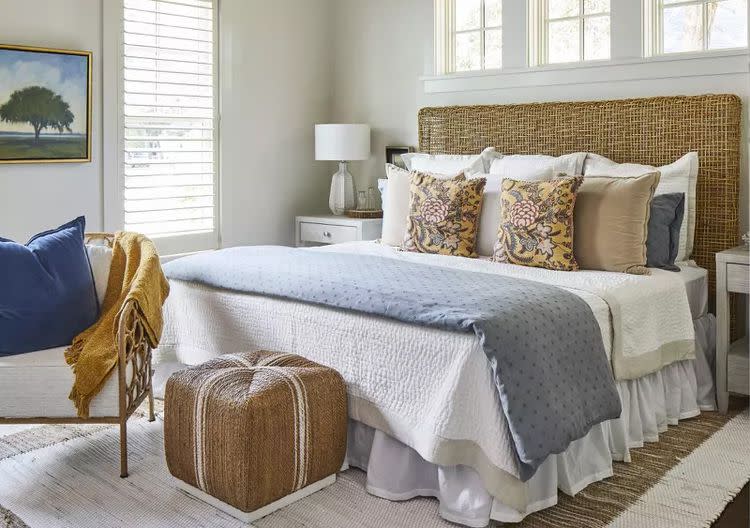Do You Really Need A Box Spring? A Sleep Coach Explains
Do you use a box spring with your mattress?

LAUREY GLENN
There are many mattresses on the market, including some that can be shipped to you in a box far smaller than you’d believe possible for a mattress. A box spring, on the other hand, with its metal or wood frame, is not nearly as packable. This begs the question: Do you even need a box spring anymore? The answer depends on the type of mattress you have.
“Traditionally, box springs were designed to provide support and absorb shock for older, more flexible mattresses,” says Jack Dell’Accio, CEO and founder of Essentia Mattress. They also elevate the bed’s height for easier access, he adds. But with new advancements in mattress technology, denser materials like foam and latex are supportive enough for a good night’s sleep and eliminate the need for a traditional box spring.
“Today, the primary benefit of a box spring is more about aesthetics and height adjustment rather than essential support,” Dell’Accio says.
Meet the Expert
Jack Dell’Accio is a certified sleep coach and the CEO and founder of Essentia Mattress.
Do Modern Mattresses Require a Box Spring?
According to Dell’Accio, who is also a certified sleep coach, modern mattresses made from high-density foam or latex are designed for placement on a solid, breathable surface, like a platform. More specifically, it should be solid or otherwise have closely spaced slats made from wood or metal—either of which are supportive enough for today’s modern mattresses.
Although box springs do indeed contain springs that are meant to flex under the weight of a mattress, they’re not really up to the task of providing support for these heavier mattresses. “This can lead to premature sagging and reduced mattress performance over time,” he says.
Related: How To Clean A Mattress, According To Experts
Factors to Consider When Deciding on a Box Spring
When you are in the market for a new mattress, a box spring might indeed be a moot point. Dell’Accio encourages consumers to focus instead on a mattress that caters to their specific sleep needs.
“Look for materials like high-density foam or natural latex that offer optimal support and pressure relief,” he says. “Ensure your foundation or bed frame provides adequate support across the entire surface of the mattress, minimizing any potential for sagging or uneven wear.”
Dell’Accio suggests a solid or slatted platform. “These alternatives offer consistent support and durability, and they are less prone to collecting dust mites compared to traditional box springs,” he says.
Related: This Is How Often You Should Flip Or Rotate Your Mattress, According To Experts
Alternatives to Box Springs
A box spring is not the only option for mattress support. Consider these three alternatives:
Platform Bed
A platform made from wood, metal, or other sturdy material provides a solid foundation for today’s heavier mattresses that don’t require a box spring. It has a minimalist silhouette, but the solid platform doesn’t allow much airflow.
Slatted Base
A slatted or panel base features slats made from wood or metal that support the mattress. It provides more airflow than a platform bed but it’s also bulkier, given that these often feature any combination of headboard, footboards, and side panels.
Adjustable Base
An adjustable base allows a mattress to recline at the head or foot, much like a reclining chair. However, it can only be used with a compatible mattress that’s flexible enough to be adjusted. Some might find it cumbersome to make the adjustments
How to Determine if You Need a Box Spring
Unless you are purchasing a secondhand mattress, you will likely be informed by the retailer or manufacturer whether your new mattress needs to be paired with a box spring. In this case, see what fits your budget and sleep preferences among the box spring alternatives discussed above.
Dell’Accio says that individuals with older, open bed frames designed for box springs can opt for one, as can anyone with a preference for a higher bed. “However, for those with specific health concerns like back pain or allergies, mattresses that require solid support are generally recommended over box springs,” he says.
Frequently Asked Questions
Can I use a box spring with different types of mattresses?
Not always. Box springs are meant to boost lighter mattresses, but today’s mattresses are heftier and designed to provide enough support on their own. We can’t stop you from using a box spring on a new mattress, but it might only serve to raise the mattress a few inches.
Can I use a platform bed without a box spring?
Yes, and in fact, you should. The solid or slatted platform is meant to provide the support needed for a heavier mattress, so there’s no need for a box spring.
Are there any benefits to using a box spring with certain mattress types?
For older, lighter mattresses, box springs will provide the necessary support to keep them from sagging. However, for newer models, a box spring is not necessary and may only serve to collect dust mites.
Should I consult with mattress manufacturers or retailers for guidance on box springs?
You should always consult with the manufacturer or retailer for any mattress purchase to ensure you are getting adequate sleep support. You’re sure to talk to a sales associate at a brick-and-mortar mattress store, but customer service is available for online retailers. At the very least, you should be able to get a yes or no answer to the question: “Do I need a box spring?”
For more Southern Living news, make sure to sign up for our newsletter!
Read the original article on Southern Living.
